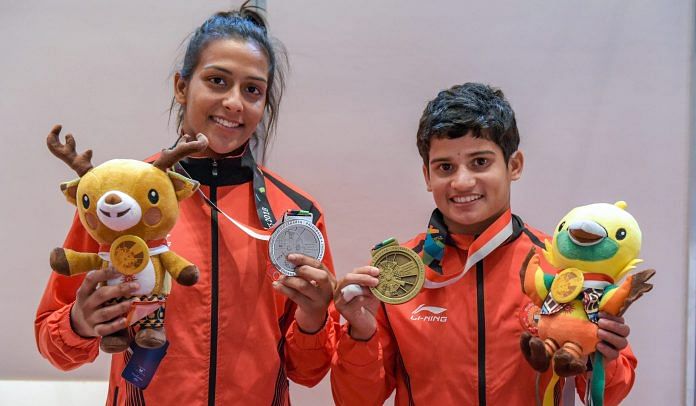The two are forms of martial art that trace their origin to different countries: Kurash is a traditional martial art of Uzbekistan, while wushu is Chinese.
New Delhi: India has won its richest ever Asiad medal haul at the ongoing Jakarta Palembang Asian Games, notching a stellar 67 by Saturday afternoon.
The bulk have been won in popular sports like badminton, shooting and wrestling, but six have come from games many people don’t even know exist: Kurash and wushu.
And then there’s Sepak Takraw, sometimes known as kick volleyball, in which India has won its maiden bronze in the team regu event.
While Pincky Balhara and Malaprabha Yallappa Jadhav won two medals in kurash, silver and bronze, respectively, Surya Bhanu Pratap Singh, Naorem Roshibini Devi, Santosh Kumar and Narender Grewal — won a bronze each in wushu.
Also read: Obsession with Asian Games’ medal tally shows India’s breathtaking apathy towards sports
But what exactly are kurash and wushu? As you scratch your head and raise an eyebrow, ThePrint explains.
What is kurash?
Resembling wrestling, kurash is a traditional martial art that originated in Uzbekistan. The 2018 Asiad is the first time the sport is a part of the mega sports tournament that made its debut in 1951.
The game involves two athletes, whose sole purpose is to throw the other on the ground.
There are three scoring techniques. When a player throws the opponent forcefully on their back, it’s called halal and it means victory. When a player throws the opponent on their side, it’s called yambosh, and earns the former some points. When the opponent is thrown “weakly”, it’s called chala and also earns the player points.
Against all odds
Pincky Balhara, who won the silver medal in Kurash, is a resident of Delhi’s Neb Sarai village. All if 19, she is a student at Gargi College, Delhi University. Before moving to kurash, she was a judoka.
Balhara is a two-time national silver medallist in judo, and also won gold in this year’s Junior Asian Championships.
Trained by her uncle Samundar Tokas, Balhara took up combat sports at the age of 10. But to her great regret, her greatest supporters have not been able to witness her journey to stardom — her father passed away earlier this year and, some weeks later, she lost her grandfather too.
Balhara couldn’t afford to buy her kit, worth around Rs 35,000, because the Kurash Association of India (KAI) is not recognised by the sports ministry. To send her to a training camp in Uzbekistan before the Asian Games, the residents of her village pooled in Rs 1.75 lakh.
Like Balhara, Malaprabha Yallappa Jadhav couldn’t afford to buy a kit either, but didn’t let the lack of funds deter her. A resident of Turmuri village in Karnataka’s Belgaum, she trained as a judoka as a child.
Her coaches M.N. Triveni and Jitendra Singh spotted her talent and decided to take her to the national sports academy in Noida. Eventually, Triveni realised that Jadhav was more suited for kurash than judo, and took her to the same training camp in Uzbekistan to which Balhara went. Jadhav was subsequently selected for the under-52 kg category.
Daughter of a marginal farmer, she has won numerous judo medals at international competitions and is also a recipient of the Ekalavya award from the Karnataka government.
What is wushu?
Wushu, or Chinese kung fu, has been a part of the Asian Games since the 1990s, and consists of two disciplines, taolu and sanda.
Taolu, an exhibition sport, is a combination of martial-art skills and gymnastics. The assessment of the athlete depends on movements like stances, kicks, punches, balances, jumps, sweeps, and throws. The competitive versions of the game have time constraints ranging from eight seconds to five minutes.
Sanda, meanwhile, is a full body-contact sport. It is a modern fighting method comprising boxing, kickboxing and wrestling. There are two athletes who participate in this game, both trying to knock the other out.
The joys and sadness of winners
All of India’s four wushu bronze medals are for sanda, for which it won two at the 2014 Incheon Asian Games. They have been won by Surya Bhanu Pratap Singh, Naorem Roshibini Devi, Santosh Kumar and Narender Grewal.
A resident of RS Pura’s Roopnagar village near Jammu, Bhanu was initially a wrestler but switched to wushu after meeting the national coach of the Indian wushu team, Kuldeep Handoo. The 24-year-old started his training when he was in school.
Dedicating his medal to the slain policemen of Jammu & Kashmir, Bhanu stated that he wants to become an Ultimate Fighting Championship star one day.
Roshibini, 17, of Manipur is the daughter of a farmer. She participated in women’s sanda 60 kg category.
Also read: P.V. Sindhu gets silver at Asian games in year’s third major final loss
Roshibini won her first bronze in the Junior Worlds in 2016, notching a gold in this year’s World Junior Wushu championships in Russia. The match that won her the Asiad medal marked the first time Roshibini’s parents had seen her competing on live television.
For Delhi’s Santosh, 2018 was his third Asiad. Born in 1991, Santosh was part of the Indian contingent at Incheon and Guangzhou games but did not win a medal.
An alumnus of Delhi University, Santosh participated in the 56-kg category. He expressed disappointment after winning the bronze, saying he had aimed for a gold.
Trained by coach Rajveer Singh, Santosh has been playing wushu since his school days. He has won multiple golds at the national level.
The 2018 Asiad bronze was the second for Narender Grewal, 24, after his win in the 60-kg category at Incheon also he had won bronze in 60 kg category. Nicknamed ‘Dynamite’, Grewal also trained under Handoo.
Santosh hails from Haryana’s Rohtak city.



